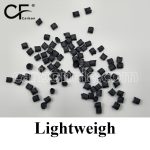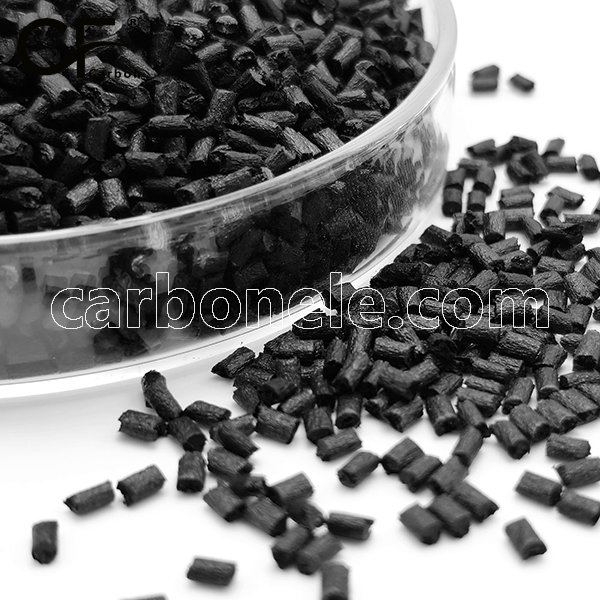
PA66-CF50: Advanced Carbon Fiber Composite
PA66-CF50 is a high-performance composite material consisting of 50% carbon fiber reinforced nylon 66 (PA66). It offers exceptional tensile strength exceeding 250 MPa, outstanding impact resistance of 140-180 kJ/m², and a low wear rate of 0.01-0.03 mm³/kWh. With a lightweight density of 1.40-1.50 g/cm³, PA66-CF50 is ideal for automotive, aerospace, industrial equipment, and high-end consumer goods applications, providing superior durability and performance in demanding environments.
- Model number: PA66-CF-BCA5
- Matrix Resin: Nylon6 6(Polyamide66) (PA66)
- Reinforcing Filler: Carbon fiber
- Appearance: Granules
- Grade: Injection/extrusion grade
- Packaging: 25kgs/bag
PA66-CF50 Overview
PA66-CF50 is a high-performance composite material created by integrating 50% carbon fiber into nylon 66 (PA66). This advanced material is engineered for applications requiring exceptional strength, stiffness, and thermal stability, making it a superior choice for the most demanding environments.
Key Features of PA66-CF50
- Exceptional Tensile Strength: The addition of 50% carbon fiber greatly increases the tensile strength of PA66 CF50, which is generally greater than 250 MPa. Its exceptional strength makes it suited for high-stress applications in the automotive, aerospace, and industrial industries.
- Lightweight Composition:PA66 CF50 is both strong and lightweight, having a density of around 1.40-1.50 g/cm³. This lightweight nature is critical in fields where weight reduction may contribute to increased performance and economy, such as automotive and aerospace applications.
- Outstanding Impact Resistance:PA66 CF50 has high impact resistance, ranging from 140 to 180 kJ/m². This property guarantees that the material can endure unexpected pressures and impacts, making it perfect for applications that need endurance.
- Enhanced Wear Resistance:Increased carbon fiber content leads to decreased wear rates, typically between 0.01 and 0.03 mm³/kWh. This feature is very useful in high-wear applications like gears and bearings, ensuring long-term performance and little maintenance.
Application Industries
- Automotive Industry: PA66 CF50 is perfect for structural components, housings, and brackets that require an exceptionally high strength-to-weight ratio. Its durability and lightweight properties make it suitable for both interior and exterior automotive applications.
- Aerospace Industry: In aerospace, the demand for lightweight yet strong materials is critical. PA66 CF50 is ideal for manufacturing lightweight components that must perform reliably under extreme conditions.
- Industrial Equipment: The material is widely used in high-performance machinery and equipment, including gears and wear-resistant parts. Its superior strength and durability make it suitable for rigorous industrial applications.
- Consumer Goods: PA66 CF50 is increasingly utilized in high-end consumer products, such as sporting goods, power tools, and durable household items, providing enhanced performance and longevity.
Summary Table
| Category | Details |
|---|---|
| Definition | PA66-CF50 is a composite material with 50% carbon fiber added to nylon 66 (PA66). |
| Advantages | 1. Exceptional Tensile Strength: Tensile strength > 250 MPa. 2. Lightweight: Density 1.40-1.50 g/cm³. 3. Outstanding Impact Resistance: Impact strength 140-180 kJ/m². 4. Enhanced Wear Resistance: Wear rate 0.01-0.03 mm³/kWh. |
| Industries of Application | 1. Automotive Industry 2. Aerospace Industry 3. Industrial Equipment 4. Consumer Goods |
If you want to get more information about PA66-CF50, you can vist our Youtube.
PA66-CF50 granules
PA66-CF50 granules typically have a round or irregular shape, with diameters generally ranging from 1 to 2 centimeters. This shape ensures uniform flow during processing, providing consistency in molding and extrusion techniques. The granules feature a smooth surface, facilitating easy mixing with other materials and enhancing their versatility across various applications. Their size also makes these granules convenient for storage and transportation, effectively minimizing space requirements. These characteristics make PA66-CF50 granules widely utilized in diverse industries, meeting various processing demands and ensuring the quality and performance of the final products.



Frequently Asked Questions
Carbon (Xiamen) New Material Co., Ltd. aims to provide buyers with "one-stop" worry-free high-quality services. Here you can find all information about carbon fiber engineering plastics. If you still have questions, please send us an email for consultation!
-
How can I contact the manufacturer of a product that interests me?
When you find a product you are interested in, you can contact the manufacturer directly by sending an email and we will get back to you as soon as possible.
-
How do I find the products that interest me?
All you need to do is enter the keyword, product name in the search window and press the Enter key on your keyboard. Your search results page will then be displayed. You can also search within the product category pages on the home page. Each category is divided into subcategories, allowing you to refine your search and find products that interest you.
-
Where will I find a buying guide?
Please contact our after-sales service directly and we will provide you with a comprehensive operating guide.
-
What are CF Reinforced Thermoplastic Composites?
CF Reinforced Thermoplastic Composites are materials where carbon fibers are incorporated into a thermoplastic matrix. They combine the strength and stiffness of carbon fibers with the processability and recyclability of thermoplastics. For instance, they are used in automotive parts like bumper beams.
-
What are the benefits of CF Reinforced Thermoplastic Composites over traditional composites?
The key benefits include faster production cycles, easier recyclability, and better impact resistance. They also offer design flexibility. An example is in the manufacturing of consumer electronics casings where complex shapes can be achieved more easily.
-
How are CF Reinforced Thermoplastic Composites processed?
Common processing methods include injection molding, extrusion, and compression molding. Injection molding is widely used for mass production. For example, in the production of small components for the medical industry.
-
What industries use CF Reinforced Thermoplastic Composites?
They are utilized in aerospace, automotive, medical, and sports equipment industries. In aerospace, they can be found in interior components. In the medical field, they might be used in prosthetics.
-
How does the carbon fiber content affect the properties of the composites?
Higher carbon fiber content generally leads to increased strength and stiffness but may reduce ductility. A moderate content is often balanced for specific applications. For example, a higher content might be preferred in structural parts of a race car.
-
What are the challenges in using CF Reinforced Thermoplastic Composites?
Challenges include higher material costs, complex processing equipment requirements, and ensuring uniform fiber dispersion. Issues with adhesion between the fibers and the matrix can also arise. An example is in achieving consistent quality in large-scale production.

























